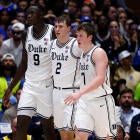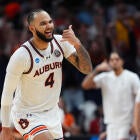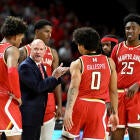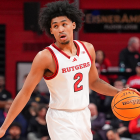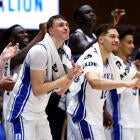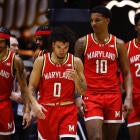
Kobe Bryant accepted an inflated contract despite the fact that it runs counter to what he insists matters most to him -- winning. And he won't stop taking last-second shots to win or force overtime even though he literally hasn't made one since 2012.
So it's not like the NBA legend has everything figured out.
I know that as well as you know that.
But that doesn't mean the central point he made Friday -- that European players are taught better fundamentals and trained more effectively at a younger age than Americans who are raised on the AAU circuit -- is incorrect, and it seems silly to be dismissive of that point simply because it's just the latest example of old-man Kobe ranting about something.
Because he does have a point.
To be clear, as is typically the case, painting with a brush as broad as the brush Bryant used on AAU basketball is, as one NBA scout told me Saturday morning, a "little too general and cliche." It makes me wonder how much Bryant truly understands the summer circuit, and it should be noted that while I've seen everybody from LeBron James to Anthony Davis to Carmelo Anthony to John Wall to Zach Randolph to Kevin Durant and Stephen Curry at various sanctioned events, I've never personally seen Kobe Bryant at one. Doesn't mean he hasn't been to one. Just means I've seen a lot of dudes but never him.
Are there too many events and games in the summer?
Yes.
Is there enough focus on skill-development?
No.
There are lots of problems with summer hoops in this country; no smart person would deny that. But the system does produce countless opportunities for kids who wouldn't otherwise have them, and there's something to be said for the way Nike has created a league that culminates with the Peach Jam and genuinely promotes team basketball.
So is AAU basketball, as Bryant put it, "horrible" and "terrible?"
Parts of it, sure.
But certainly not all of it.
And Bryant is wrong to suggest as much.
That said, I texted or called six different NBA front-office executives or scouts Saturday morning, and five of the six said that, yes, Bryant is probably right that European players, in general, are taught basketball more effectively than American players, and that they, per capita, become better passers and cutters and fundamentally sound prospects.
Again, this is not true across the board.
(Who's more skilled than Stephen Curry from America?)
But if Bryant's main point -- and I think this was Bryant's main point, even if he made it sloppily -- is that American prospects would be better served with fewer games and more instruction, well, I think that's a reasonable point to make. And it made me remember a story I read in the New York Times a few years back headlined "How a Soccer Star Is Made."
The story detailed how prospects in the youth academy (De Toekomst) for the famed Dutch soccer club Ajax train, and I've always remembered how it's basically the opposite of the way basketball prospects are trained in this country. Simply put, they barely play games or compete against anybody other than themselves. It's just practice, practice, practice.
Here's an except:
In all age groups, training largely consists of small-sided games and drills in which players line up in various configurations, move quickly and kick the ball very hard to each other at close range. In many practice settings in the U.S., this kind of activity would be a warm-up, just to get loose, with the coach paying scant attention and maybe talking on a cellphone or chatting with parents. At the Ajax academy, these exercises -- designed to maximize touches, or contact with the ball -- are the main event. “You see this a lot of places,” a coach from a pro club in Norway, who was observing at Ajax, said to me. "Every program wants to maximize touches. But here it is no-nonsense, and everything is done very hard and fast. It’s the Dutch style. To the point and aggressive." ... [Professional player] Gregory van der Wiel’s description of the detail-oriented routine at De Toekomst struck me as dead on: "You do things again and again and again, then you repeat it some more times."
And then there's this from that same story:
(It was written about American soccer but could just as easily be about American hoops.)
Americans place a higher value on competition than on practice, so the balance between games and practice in the US is skewed when compared with the rest of the world. It’s not unusual for a teenager in the US to play 100 or more games in a season, for two or three different teams, leaving little time for training and little energy for it in the infrequent moments it occurs. A result is that the development of our best players is stunted. They tend to be fast and passionate but underskilled and lacking in savvy compared with players elsewhere. “As soon as a kid here starts playing, he’s got referees on the field and parents watching in lawn chairs,” said John Hackworth, the former coach of the U.S. under-17 team and now the youth-development coordinator for MLS's Philadelphia franchise. “As he gets older, the game count just keeps increasing. It’s counterproductive to learning and the No. 1 worst thing we do."
I agree with every word of that.
I'm guessing Kobe Bryant probably does, too.
But, as DraftExpress.com's Jonathan Givony told me Saturday, Bryant is one of the few on this planet who could actually help change this, if he wanted. But it's much easier to spew generalities than it is to work toward solving whatever problems might exist.
"Instead of getting on his soapbox and blaming the sneaker companies, maybe Kobe should take some of the hundred-plus million [dollars] he's earned from those same sneaker companies and reinvest it in helping cure some of the problems he's laid out," Givony said. "No one has a bigger platform than him to do something like that, and it seems a little hypocritical to be taking so much money from these 'evil people' on one hand and then slamming them at the same time, while not doing anything about it."
![[object Object] Logo](https://sportshub.cbsistatic.com/i/2020/04/22/e9ceb731-8b3f-4c60-98fe-090ab66a2997/screen-shot-2020-04-22-at-11-04-56-am.png)










